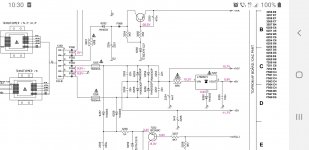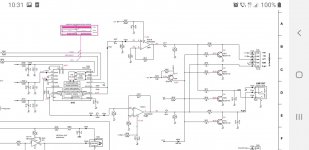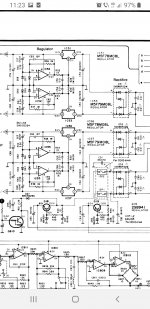As much as I would rather have regulation, I find my self many times just using a simple 2-4 stage C-R-C filter (straight off a bridge rectifier) to power both sides of the opamp is sufficient when I am designing circuits on proto boards, I do measure a quite difference in the noise floor level using them and when supplying that with a regulator it is hard to find the noise floor sometimes, due to my surrounding ambient electrical noise as seen on my scope, I have even used a stack of some small diodes to drop the voltage just enough to let them run safely without being in an over voltage condition, as in my Regulated 0-14KV ESL Bias supply project.........
Still works to this day !! 😉
jer 😀
Still works to this day !! 😉
jer 😀
When people keep asking.. ' is that anyway better?' will be a never ending story like the railway lines.
There is always a this and a that available and you end up spending more and more, And the question 'is that anyway better?' always remains.
Regards.
There is always a this and a that available and you end up spending more and more, And the question 'is that anyway better?' always remains.
Regards.
For esl bias you can use resistors in the tens of megaohms and caps in the pico...nanofarads range...No real load to supply...As much as I would rather have regulation, I find my self many times just using a simple 2-4 stage C-R-C filter (straight off a bridge rectifier) to power both sides of the opamp is sufficient when I am designing circuits on proto boards, I do measure a quite difference in the noise floor level using them and when supplying that with a regulator it is hard to find the noise floor sometimes, due to my surrounding ambient electrical noise as seen on my scope, I have even used a stack of some small diodes to drop the voltage just enough to let them run safely without being in an over voltage condition, as in my Regulated 0-14KV ESL Bias supply project.........
Still works to this day !! 😉
jer 😀
Some try to prove a point by using an exception 🙂
I have heard/see some installations of people that don't believe in conventions and standards and that everything active sounds bad, regulators are 666, jitter is no issue (as they have very jittery DACs) etc. They have 8V rms output DACs, 100 mV sensitive tube amplifiers, unshielded silver wire etc. No way that these will accept any standard practice. Trouble for me then is that nothing is interchangeable with normal equipment and comparison seems to prove their point (and also my point). Makes no sense to have any listening test then.
If OP wants to do stuff unregulated OP must prepare for spending a lot of time and money and needs a big casing for a small device. It can be the best of devices unregulated and he will gain a lot of experience. In my experience a device is as good as its PSU.
I have heard/see some installations of people that don't believe in conventions and standards and that everything active sounds bad, regulators are 666, jitter is no issue (as they have very jittery DACs) etc. They have 8V rms output DACs, 100 mV sensitive tube amplifiers, unshielded silver wire etc. No way that these will accept any standard practice. Trouble for me then is that nothing is interchangeable with normal equipment and comparison seems to prove their point (and also my point). Makes no sense to have any listening test then.
If OP wants to do stuff unregulated OP must prepare for spending a lot of time and money and needs a big casing for a small device. It can be the best of devices unregulated and he will gain a lot of experience. In my experience a device is as good as its PSU.
Last edited:
Just to throw another monkey wrench, I'm trying out some DC-DC convertersWhen people keep asking.. ' is that anyway better?' will be a never ending story like the railway lines.
There is always a this and a that available and you end up spending more and more, And the question 'is that anyway better?' always remains.
Regards.
to reduce heat. Latest project needs 3.3V at around 700mA. With a 12V supply
and linear regulator you make 6 Watts of heat besides the 2 Watts used on the
3.3V bus. Converters knock that below 3 Watts vs 8. Five Watts in a small (100
cubic inch) box is a big deal. In my pro video designs I used precision +/- 5V
references to get rid of drift. The supplies were better than my 4.5 digit Fluke
meter meaning you could (and I once did) calibrate the meter to the machine
after verifying with 2 other meters. As far as I can tell, the powrer supply should
be the best you can afford.
G²
👍👍In my experience a device is as good as its PSU.
As usual, dispute arises from a question “what a good PSU is”. 😀
I’m always in favor of regulated PS, but that doesn’t mean I don’t use unregulated PS at all. Measuring transient response and harmonics at PS rails under dynamic load, reveals the truth which one is better.
If it was not described clear enough: either regulated or unregulated but with high quality in mind. Not lowest cost/least effort or because of dogmatic disapproval of a certain topology. If one is inexperienced and not willing to spend time and energy on a high quality unregulated PSU then that 7812/7912 combo might give more value in less time with more or less predicable results certainly when "fast" opamps are used.
I know I am a stubborn person but post #1 by the OP says "preamp". It could be a buffer or a device that attenuates but in all cases it is meant to be used with audio line level signals.
I know I am a stubborn person but post #1 by the OP says "preamp". It could be a buffer or a device that attenuates but in all cases it is meant to be used with audio line level signals.
Last edited:
Some try to prove a point by using an exception 🙂
If OP wants to do stuff unregulated OP must prepare for spending a lot of time and money and needs a big casing for a small device. It can be the best of devices unregulated and he will gain a lot of experience. In my experience a device is as good as its PSU.
I see today's overkill design trends ...but I see no value in them as some use same amounts of capacitors as in a 5kWatts stage amplifier AND regulators.
As the OP example was NOT a preamplifier at all I feel free to talk of any type of circuit using op-amps supply.
I was first opened to non regulated designs when I saw the internals of a newly bought Marantz CD 5000 player..Then chequed its schematic and recognized there's no regulator for the analogue part...just a very small RC filter...
http://www.lampizator.eu/lampizator/references/Marantz CD5000/marantz5000.html
https://www.canuckaudiomart.com/det...layer-according-to-lampizator/images/2178825/
A stage amplifier like qsc rmx2450 uses 2x 12000uf series coupling (and filtering) output cap to deliver 2400 watts into 4 ohms when bridged.Some "audiophile"preamps use higher capacitances to deliver 10 mWatts into 600 ohms...
Attachments
Last edited:
78xx/79xx... "overkill"..... 😀 From line level to power amplifiers (that are almost always unregulated for quite obvious reasons)...
Thread title is: "Is regulation really necessary/desirable for preamps?"
Time to do something useful. Ciao!
Thread title is: "Is regulation really necessary/desirable for preamps?"
Time to do something useful. Ciao!
Last edited:
I don't remember pointing to 78xx here, otherwise 78xx and 79xx based regs can be overkill if used by a true designer! Besides the title of the topic and the mention by the Original Poster for 78/79xx regs, I need to point out for the THIRD time that the Original Poster used the wrong example out of a thousand possibilities...Why should I talk about a preamplifier if he seems to have no ideea what a pre-amplifier means reffering to the opposite of it? I thought he maybe made a mistake or even a deliberate one...yet what if he actually doesn't know at all what a pre-amplifier is!? At least he can modify his first post and add some clarity to it.
Attachments
Last edited:
The schematic in the first post was purely an example of the type of circuit we are talking about, not necessarily the exact one to be used since this was a general inquiry.Why should I talk about a preamplifier if he seems to have no ideea what a pre-amplifier means reffering to the opposite of it? I thought he maybe made a mistake or even a deliberate one...yet what if he actually doesn't know at all what a pre-amplifier is!? At least he can modify his first post and add some clarity to it.
However, why would you say that it is not a preamp?
Unless I completely misunderstand the maths here:
The first section has a gain of (2.2k + 4.7k)/4.7k = 1.46x
The second section has a gain of (2.2k + 3k)/3k = 1.733x
1.46x1.733 = 2.53x gain. Not including the setting of the volume pot.
Am I mistaken?
Sorry, you're NOT mistaken, you're right! I didn't see the ground sign...I assumed it's inverting topology.My bad! With those gains you don't get much psrr indeed but lme49720 is good even in unity gain at rejecting ps noise.With lm49720 you get "good" EMI though ...so shielding is a must.
Last edited:
His example is not a preamplifier...its gain is negative..
So, you say that anything with less than ++unity gain, in example First Watt F4, can’t have word amplifier attached? Post that in the Pass Labs forum section. I’ll fetch popcorn. 🙂
Voltage gain is not a measure if something can be called pre/amplifier. At least while there is some current gain.
It's a voltage amplifier here...not tranconductance or current amps so , yes, no amplifier word attached to subunity voltage gain here .My bad again...I don't bother post in fanboys house too much...Too dangerous!
It is a mistake made by you, not by the fanboys whoever that may be nor by posting "in a fanboys house" whatever that may be.
Valve preamplifiers are class A which means, given a well decoupled supply, their current draw is independent of signal level. Op amps all have class B output stages which means their current draw is directly dependent on signal level, This is a major difference and a major issue for a regulator.Valve preamplifiers with considerably worse PSRR than op-amps are often supplied from a well-filtered, but unregulated supply, so that should also work for op-amp circuits. A minor disadvantage is the less predictable headroom. Power efficiency can be both better and worse, depending on the voltage drop across the filter and the regulator, but is not much of a concern for a preamplifier anyway.
Cheers
Ian
Not really...some op amps have significant idle currents, especially the high slew rate ones.Even looking into their guts when available some show clear class AB output stage while others are purely class A op amps(diamond buffer ones).Op amps all have class B output stages which means their current draw is directly dependent on signal level, This is a major difference and a major issue for a regulator.
Cheers
Ian
I admitted my mistake , not going to be submissive to anyone on anything they bring up!It is a mistake made by you, not by the fanboys whoever that may be nor by posting "in a fanboys house" whatever that may be.
The circuit I thought the OP was depicting at first not seeing the ground sign would have been a voltage divider so it has a name and it was not an amplifier really...
https://electronics.stackexchange.c...ffered-voltage-divider-vs-inverting-amplifier
Last edited:
Off topic??? The first post says: "For something like a fairly generic OPamp based preamp, is a regulated PSU really that important?"By the former off topic king: not all opamps have class B output stages. Besides that please have a look at post #1 yes the first post so the subject. The schematic contains current sources...
Cheers
Ian
- Home
- Source & Line
- Analog Line Level
- Is regulation really necessary/desirable for preamps?



